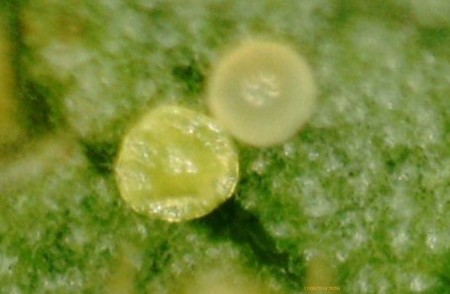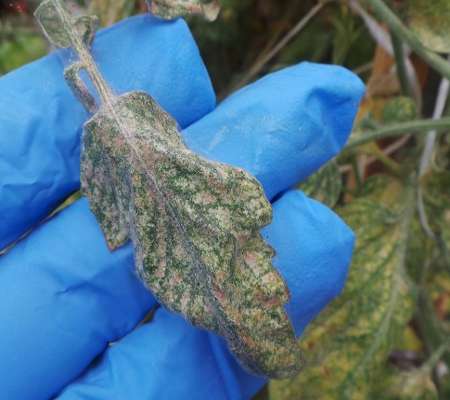By Thomas Ford
Spider mites in general thrive under warm conditions and can go from egg to adult in seven days. Each female two-spotted spider mite can lay approximately 100 eggs. In a few short weeks, in the absence of any biocontrols, two-spotted spider mite populations can seem to explode overnight, resulting in stippled leaves, defoliation, and even plant death.

Figure 1: Spider mite eggs appear as small spheres on the undersides of the leaf.
Spider mites have a broad host range and are said to be capable of feeding on almost any crop in the greenhouse or high tunnel. Spider mites injure plants directly by inserting their piercing mouthparts into the leaves to remove cellular content. Spider mites remove chlorophyll from the leaf which reduces the plant’s overall ability to photosynthesize or produce food.

Figure 2: Two-spotted spider mites are first detected on the lower leaf surface
Spider mites exhibit different feeding behaviors at different population densities. When the population is low, spider mites will confine their feeding to the undersides of the leaf’s surface. As the population explodes spider mites become visible on the upper leaf surface and may produce silken webs that can cover the entire plant.
Greenhouse/high tunnel growers often refer to themselves as “wet” growers or “dry” growers. In respect to spider mites, “dry” growers tend to observe more spider mite problems than “wet” growers because spider mites tend to develop faster on water-stressed plant materials.
Growers should scout greenhouses/high tunnels weekly for the signs of two-spotted spider mite infestations. Stippling of the lower leaves is the first sign of a spider mite infestation. A 10X hand lens works well to visually detect the presence of eggs, larvae, and adult mites. Tapping leaves over a white piece of paper or over a white clipboard can reveal the presence of two-spotted spider mites on the white surface to the person scouting the crop.
Biological control should be the primary pest management strategy utilized by growers to manage two-spotted spider mites in greenhouses and high tunnels. Biocontrol agents frequently deployed by greenhouse growers include:
- Galendromus occidentalis (predatory mite)
- Mesoseiulus longipes (predatory mite)
- Neoseiulus californicus (predatory mite)
- Neoseiulus fallacis (predatory mite)
- Phytoseiulus persimilis (predatory mite)
- Feltiella acarisuga (predatory midge)

Figure 3: Phytoseiulus persimilis is just one of many predaceous mites that can be used as a biocontrol for two-spotted spider mites.
Bicontrol agents like Phytoseiulus persimilis and Neoseiulus fallacis are relatively quick acting and can contain a spider mite outbreak very quickly. Many predatory mites do not perform as well on plants with trichomes (hair-like projections on the plant) when compared to plants with no trichomes.
If a grower would prefer to apply a registered miticide in lieu of utilizing biocontrol agents, they should consider applying and rotating the following registered products to prevent pesticide resistance. Please review the label carefully before application to make sure that the pesticide product is labeled for the crop that you are targeting.
- abamectin (Agri-Mek SC)
- chlorfenapyr (Pylon)
- Chromobacterium subtsugae Strain PRAA4-1 (Grandevo)
- horticultural oil ( Suffoil-X, Ultra-Pure Oil)
- insecticidal soap (M-Pede, Kopa)
- Isaria fumosorosea Apopka Stain 97 (Ancora)
- neem oil (Triact 70)
- rosemary & peppermint oil (Ecotec)
- soybean oil, garlic oil, capsicum oleoresin extract (Captiva)
Miticides should be applied at 5–7-day intervals unless otherwise directed by the label. It is recommended to mark a few plants with a stake or ribbon prior to making a miticide application. The plants that have been tagged should be examined carefully with a 10X hand lens a few days after the application to evaluate the efficacy of the product used against the spider mite population.

Figure 4: Two-spotted spider mite infestation on greenhouse tomatoes.
Some growers frequently express concerns about resistance issues in two-spotted spider mite populations to some popular miticides. While resistance can be observed, I attribute most miticide “failures” to spray coverage issues by the applicator. Spider mites tend to be located on the lower leaf surface early in the infestation cycle and move to the upper leaf surface as the population explodes. Thorough coverage of the upper and lower leaf surface is essential if good control is to be achieved.
Source : psu.edu